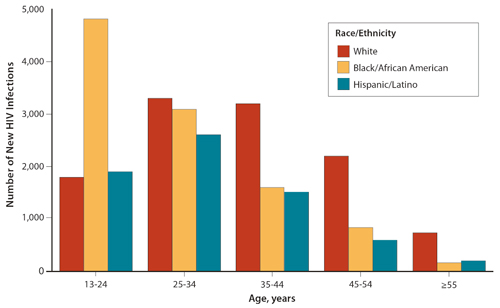- US MSM (male-sex-males) 200 times the odds of infection compared to straight Americans
- Black gay and bisexual males, 4 times as likely as white males to get infected
- Black MSM between 13-24 have the highest rate, almost quarter of all new infections, despite being a tiny US demographic
Sept. 16, 2013
NewsRescue– Despite advances in therapy, greater awareness and societal de-stigmatization of homosexuality in the US, the group still faces rising rates of HIV infection.
Among others, the rate of new infections has leveled up, raising hopes of control, however among the MSM (male-sex-male) group in the US, the new data is not very encouraging as their rate of infection has been rising over the years.
CDC data from 2010 revealed that MSM, who are an estimated 2% of the US were responsible for 78% of HIV infections, with African-American MSM being at highest risk. This gives MSM a staggering 200 greater odds of infection than straight Americans.
CDC: HIV Among Black/African American Gay, Bisexual, and Other Men Who Have Sex With Men
In the United States, gay, bisexual, and other men who have sex with men (MSM) are disproportionately affected by HIV. MSM represent approximately 2% of the US population, but accounted for more than half of all estimated new HIV infections annually from 2008 to 2010. Among MSM, black/African American MSM—especially young black/African American MSM—are at highest risk of HIV. In 2010, black/African American MSM accounted for almost as many new HIV infections as white MSM, despite their differences in population size.
According to the CDC, Young black/African American MSM aged 13 to 24 are at greatest risk of infection, with 4,800 of the 10,600 new cases among black MSM in 2010.

- Among MSM in 2011 in the United States, black/African American MSM accounted for the largest estimated number and percentage of diagnoses of HIV infection (11,805, 39%), followed by white MSM (10,375, 34%) and Hispanic/Latino MSM (6,949, 23%).
- Among MSM in 2011, black/African American MSM accounted for the highest estimated number and percentage of AIDS diagnoses (6,468, 39%), followed by white MSM (5,648, 34%) and Hispanic/Latino MSM (3,758, 23%).
- In 2010, there were an estimated 440,408 MSM living with diagnosed HIV infection. Of those, 134,746 were black, 205,195 were white, and 84,758 were Hispanic/Latino. -CDC
Poverty, lack of access to healthcare and lower education are some of the reasons why black MSM are disproportionally infected with HIV, compared to other groups.
Biological factors, including the receptiveness of the anal epithelium to HIV virus is a major contributor to the overall aggravated rate of infections in gay and bisexual males. Chris Beyrer, a professor at Johns Hopkins Bloomberg School of Public Health and a lead writer on The Lancet series, said: “Unfortunately, what we’ve identified is the global epidemic of HIV among MSM is a consistent pattern of expanding prevalence, whereas other populations have leveled off.”
The government budget for preventive health care has also been facing cuts due to the recession, wars and increased US engagement overseas. New York, one of the states with the highest infection rates has had health care budget cuts, leading to reduced awareness and preventive health care campaigns, with this major health care concern being considerably neglected.
Blacks also have a larger proportion of ‘down-low’, bisexual males, this has led to an increased risk of HIV among black females who account for 66% of infections among women, despite blacks being 15% of the US population. Bisexual males serve as a conduit transferring the virus from the epidemic in the MSM community to straight females. AIDS has in recent years been listed as a leading cause of death for black women aged 25-34. Gladly there has been a 20% decrease in new infections in black women between 2008 and 2010.
Featured image: CDC





